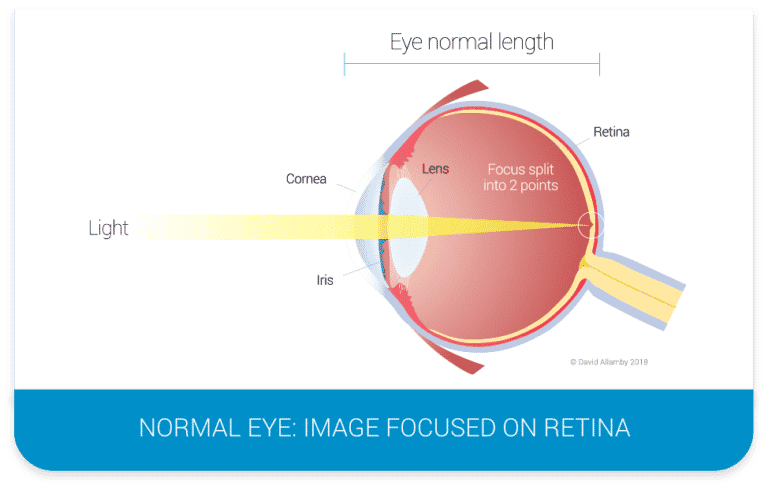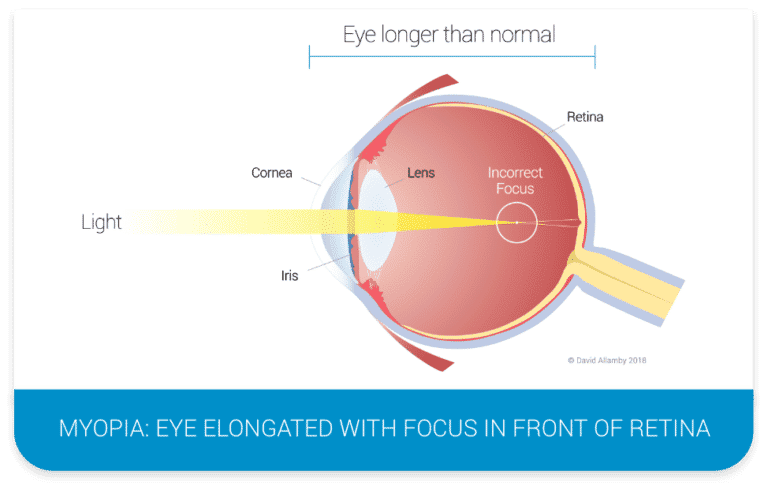Book Your Free Consultation
Mr David Allamby
MD, FRCOphth, FRCS
Prices for treatments in our London clinic start from £4,400 for both eyes.
Book Your FREE
Telephone Consultation
We can give you a good idea of your suitability over the phone and schedule you for an initial consultation.
Prices for laser eye treatments in our London clinic start from £4,800 for both eyes.
Book Your FREE
Telephone Consultation
We can give you a good idea of your suitability over the phone and schedule you for an initial consultation.
Prices for laser eye treatments in our London clinic start from £4,800 for both eyes.
Book Your FREE
Telephone Consultation
We can give you a good idea of your suitability over the phone and schedule you for an initial consultation.
We have maintained that record for the past 4 years. Almost all patients can see better than 20/20.
We know of no other clinic that has matched our vision results.
Shortsightedness is more accurately known as myopia. With short-sight (or near-sight in the USA), vision is best at short range, hence the name – near objects such as text, print, and mobile phones are clear. The distance vision, however, is blurry making it difficult to watch television or a film, read subtitles or drive a car.
When someone suffers from short-sight (near-sight), they will require corrective lenses, either spectacles or contact lenses. Such glasses or lenses will allow the distance vision to become clear.
Laser surgery can cure short-sight once the condition is no longer progressing, and LASIK is the preferred option. Key points for LASIK:
Laser vision surgery (LASIK) for short-sight is the treatment of choice in most cases. 97% of Focus patients receive A-LASIK and 3% undergo PRK.
A-LASIK is an advanced form of LASIK utilising a high numerical aperture femtosecond laser to create the LASIK flap, creating a remarkably accurate focus for precision treatment.
Using the WaveLight laser, which removes less corneal tissue per dioptre than other lasers, we are able to treat most patients up to -10.00 dioptres. This represents more than 98% of all short-sighted prescriptions.
Focus have targeted the best reported outcomes for treating myopia in the UK – 100% of our typical shortsighted patients see 20/20 or better after having LASIK eye surgery.
At Focus Clinics, our team has over 70 years of combined industry experience and has completed over 60,000 successful surgeries.
Want to see real reactions from real people, just moments after they've had laser eye surgery?
Speak To The Team
We can give you a good idea of your suitability over the phone and schedule you for an initial consultation.
In a normal eye light enters through the cornea, passes through the pupil (the natural opening in the iris) and continues through the lens located just behind the iris. If there is no refractive error (a glasses prescription) the cornea and lens focus the parallel light rays to converge together to make a sharp image on the retina. This light-sensitive layer converts the light into information that passes along the optic nerve emerging from the back of the eye, taking the vision data to the rear part of the brain; the so-called occipital lobe then processes this information so that you get a visual perception and awareness of the world around you.

Myopia, the medical term for near-sightedness, is most commonly caused by growth of the eyeball, with the eye becoming longer from front to back. Often the front focusing part of the eye (the cornea and lens) is completely normal but the ‘screen’ where the image is projected onto is too far back. The image is now incorrectly in front of the retina, with the light rays crossing and continuing to form a blurred image.
Myopia typically begins in the teenage years, and gradually progresses with worsening distance vision over the next 10-15 years. With higher levels of short-sight the condition may begin before the age of 10.
Previously, myopia would stabilise in the early 20s and the patient would no longer need regular increases in the strength of their glasses. In recent years, with much greater use of computer screens, mobile phones, and handheld devices, we are seeing myopia continue to progress through the 20s and even into the 30s. Some reports have even talked about an “epidemic of myopia”.
Some children do not realise at first that their sight is not as good as it could be. They may be able to read books and do close work without difficulty. However, seeing distant objects such as the board at school may become hard. They may think this is normal and not tell anyone. Schoolwork may suffer for a period before the condition is identified and treatment provided.
Most patients are ready to have laser eye correction between 25 and 30, although some may be ready earlier, depending on, e.g. when they first needed glasses.

Speak To The Team
We can give you a good idea of your suitability over the phone and schedule you for an initial consultation.
There are three forms of treatment for myopia, although the first, laser eye surgery, is by far the most used:
LASIK is the most performed eye surgery in the world, after cataract surgery, and is most likely the procedure you will have if you are short-sighted.
History of laser eye treatment
PRK was the first form of laser eye surgery introduced in first in late 1988. LASIK was introduced soon afterwards in 1989, performed by Ioannis Pallikaris in Crete. LASIK soon became the most popular procedure due to its lack of pain and rapid visual recovery.
Like other forms of refractive surgery, LASIK and PRK reshape the cornea to enable light entering the eye to be correctly focused on the retina for clear vision.
To correct myopia, the cornea needs to be flattened and made less powerful as a lens. This is achieved using an excimer laser, a cool-beam ultraviolet device that can evaporate corneal tissue without burning. Each pulse of the laser removes a depth of 0.2 microns (thousandths of a millimetre). Pulses are scattered across the cornea in a pre-determined pattern to remove enough tissue to correct the specific prescription being treated.
Using the extremely fast WaveLight laser, most prescriptions can be fully treated in only 4-10 seconds.
Speak To The Team
We can give you a good idea of your suitability over the phone and schedule you for an initial consultation.
Getting my laser eye surgery with Focus was the best decision I ever made. They were so professional and thorough from start to finish. I was clearly informed of all steps from start to finish and on the day of the surgery I was looked after so well, Dr Allamby did an amazing job, it was so quick, easy and painless that I didn't even know it had happened at first!
It's been 3 months since I had my laser eye surgery and I can confirm that the results have been impeccable! The team have always been very professional, attentive and caring. All the aftercare advice provided has really helped my eyes to heal and I can confidently say that they feel more than brand new.
It's been 5 years since i've had laser eye surgery done and it is honestly the best amount of money I have ever spent in my life. I've been suffering for years wearing contact lenses and glasses with constant headaches and dry eyes...For anyone wondering if they should do it, please please please go ahead and do it!
Free retreatment is available if you return to a significant prescription after the initial surgery during the first ten years.
LASIK, or “laser-assisted in situ keratomileusis,” is the most commonly performed surgery to correct myopia (short- or nearsightedness). It can also be used for hyperopia (long- or farsightedness) and astigmatism. At Focus Clinic, LASIK is the treatment of choice for 97% of cases.
First, one of our surgeons uses a Ziemer femtosecond laser to create a very thin, precise circular “flap” in the cornea. N.B. An older version of LASIK used a mechanical surgical tool called a microkeratome – this is outdated and should be avoided.
The surgeon then gently folds back the hinged flap to gain access to the underlying cornea (known as the stroma) before using the WaveLight excimer laser to correct your short-sighted prescription.
After the laser has corrected the cornea, the flap is then laid back in place covering the area where the corneal tissue was removed. Then cornea is allowed to heal naturally. The skin surface will seal the edge of the flap within 4 hours.
Surgery requires only topical anaesthetic drops, and no bandages or stitches are needed.
In most cases LASIK is pain-free and completed within 10 minutes for both eyes. The results are usually obvious instantly – most patients can see fairly well as soon as they sit up and achieve 20/20 vision between 5 and 30 minutes after the end of the procedure.
PRK (an acronym for photo-refractive keratectomy) is a type of laser refractive surgery to correct near-sight. It can also be used for mild degrees of hyperopia (farsightedness) and astigmatism.
You will also see this treatment being referred to as LASEK and involves a minor difference in the handling of the surface skin layer. However, both procedures are identical in visual outcomes and pain. Healing time can take longer with LASEK, and so in practice PRK is the most common of these two ‘surface ablation’ techniques. In effect you can use the terms PRK and LASEK interchangeably.
PRK was the first type of laser eye surgery for vision correction and was first performed in 1988. It is the fore-runner to the most commonly performed procedure: LASIK.
PRK recovery takes a longer than recovery from LASIK eye surgery, between 3 and 5 days for most patients. The first 2-3 days are often painful and vision is not very clear.
PRK is still commonly performed and is used mainly when LASIK is not possible, for example a thin cornea or when the patient expresses a preference. Like LASIK excimer surgery, PRK works by reshaping the cornea allowing light entering the eye to be correctly focused on the retina for clear sight.
With the WaveLight system, we do not tell the laser which procedure is being performed – the excimer laser ablation is exactly the same for PRK and for LASIK
For both PRK and LASIK, the excimer laser sculpts the stromal layer of the cornea to correct your prescription. The main difference between PRK and LASIK is that with LASIK a thin, hinged flap is created on the cornea to access the inner layers; in PRK no flap is created – just the surface skin layer is removed and the excimer laser energy is applied to the top layer of corneal collagen (the stroma).
Laser eye surgery can effectively correct short-sightedness, also known as myopia. LASIK, the most common procedure, reshapes the cornea to allow light to focus correctly on the retina, providing clear distance vision. Most patients experience improved vision immediately after the procedure, with 20/20 vision often achieved within minutes. PRK, another laser option, is suitable when LASIK isn't ideal, though it has a slightly longer recovery period. Both LASIK and PRK are highly effective in treating myopia, allowing most patients to reduce or eliminate the need for glasses or contact lenses.